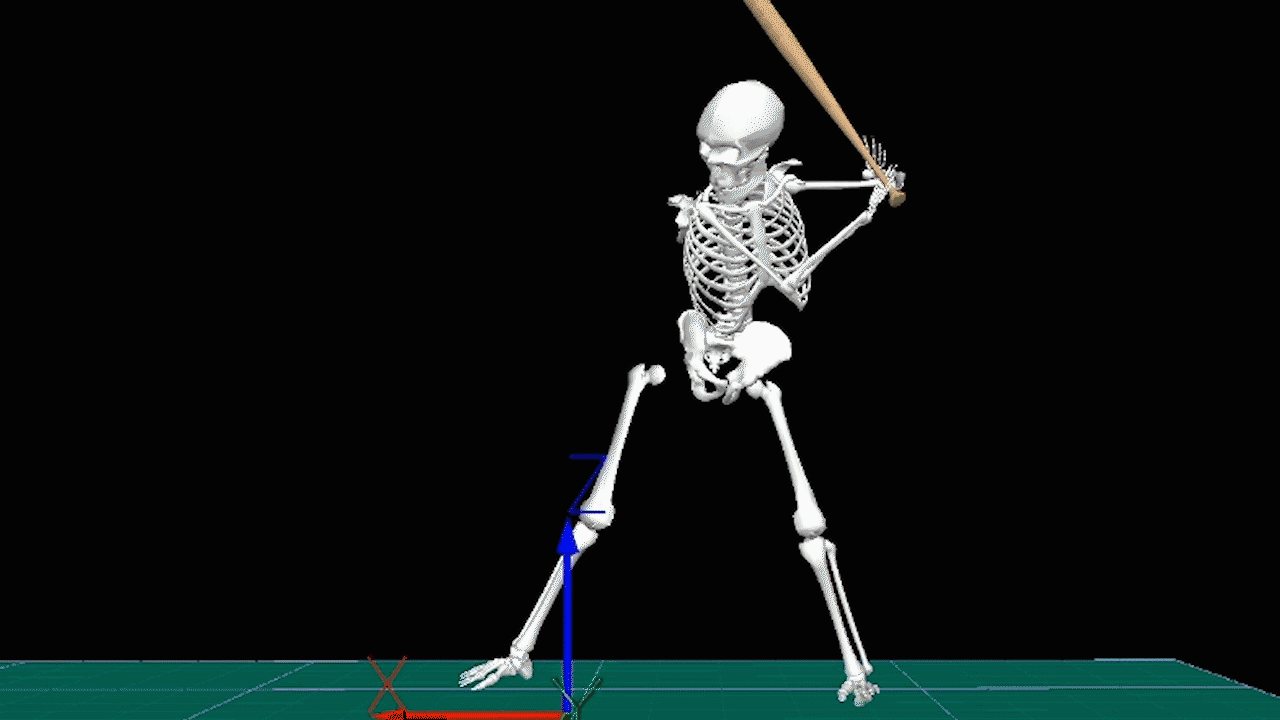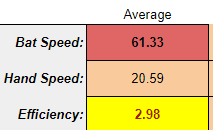Measuring and Improving Baseball Swing Efficiency

Bat speed is extremely important if you want to be a successful hitter at a high level (more details on bat speed here). With that in mind, a hitter can get a ton of value out of a swing metric that tells them how well, or efficiently, they are creating bat speed.

Foundations of Hitting
30 modules teaching you everything we know about hitting and hitting mechanics.
What is Swing Efficiency?
Swing Efficiency is defined as average bat speed divided by average peak hand speed during a swing. In other words, it tells a hitter how well they are turning their hand speed into bat speed, with a higher score being more “efficient.”
For reference, the average swing efficiency for in-gym professional hitters at Driveline is 3.25. Anything under 3.20 we would flag as a metric that needs improvement.
Examples:

- Low swing efficiency
- Pretty good hand speed
- Very slow bat speed
- Minor swing adjustments could lead to significant bat speed gains

- Very high swing efficiency
- Slow hand speed
- High bat speed relative to hand speed
You can track efficiency on your own with any type of bat sensor. Blast Motion, Motus Batting, Diamond Kinetics, etc. all have their unique version of bat speed and hand speed metrics. The example metrics above were measured with Blast sensors, so here’s how Blast Motion measures bat speed and hand speed:
Bat speed: Velocity of the sweet spot of the bat at contact
Peak hand speed: Max speed of the handle of the bat at any point during the swing (measured six inches from the knob)
Below are some examples of what good swing efficiency might look like on video. Each hitter’s style is a little bit different, but notice how each hitter starts unhinging their wrists, or “releasing the barrel,” just before and through impact with the baseball.



Bat speed: Velocity of the sweet spot of the bat at contact
Peak hand speed: Max speed of the handle of the bat at any point during the swing (measured six inches from the knob)
Below are some examples of what good efficiency might look like on video. Each hitter’s style is a little bit different, but notice how each hitter starts unhinging their wrists, or “releasing the barrel,” just before and through impact with the baseball.
How to Build Bat Speed
If you are looking to gain some extra bat speed (and you should be), then you should take a look at your efficiency. There might be some “low hanging fruit,” or minor adjustments you could make in your swing that could pump up your bat speed numbers.
The faster your bat is moving at contact, the harder you are going to hit the baseball, assuming flush contact is made. The harder you can consistently hit the baseball, the more success you are going to have at the plate. If your bat speed and efficiency are low, your bat is most likely peaking at the wrong time.

Become the Hitter You Want To Be
Train at Driveline
Some potential causes of low efficiency include:
- Poor swing direction
- Bad bat path
- Not loading/hinging the wrists
- Early barrel release/unhinging the wrists too early
- Not releasing or unhinging the wrists after contact
How to work on this:
- Training tools
- Hitting Plyo Ball ® – Forces hitter to be in a good position at contact, release the barrel through contact
- Long bat – Helps with sequencing and bat path
- Handle load (Bat speed trainer) – Helps with swing direction and rotation
- Drills
- Offset rotation – Improve swing direction
- Inside tee constraint – Bat path and releasing the barrel through contact
- Around the world – Improve contact quality to all fields
As you get comfortable, try combining some of the constraints listed above—for example, offset rotation with the handle load bat and hitting Plyo Ball ®. If you want to make it even more difficult, mix in the mini hitting Plyo Ball ® and alternate swings with the handle load and the long bat. Get weird with it.
Improving swing efficiency can be a difference-maker for a hitter. Not only will it improve bat speed and potential for exit velocity, but higher efficiency is typically the result of a better bat path. As bat path improves, so does adjustability and contact quality, ultimately helping hitters be more successful in the box.
Train at Driveline
Interested in training with us? Both in-gym and remote options are available!
- Athlete Questionnaire: Fill out with this link
- Email: [email protected]
- Phone: 425-523-4030
Comment section